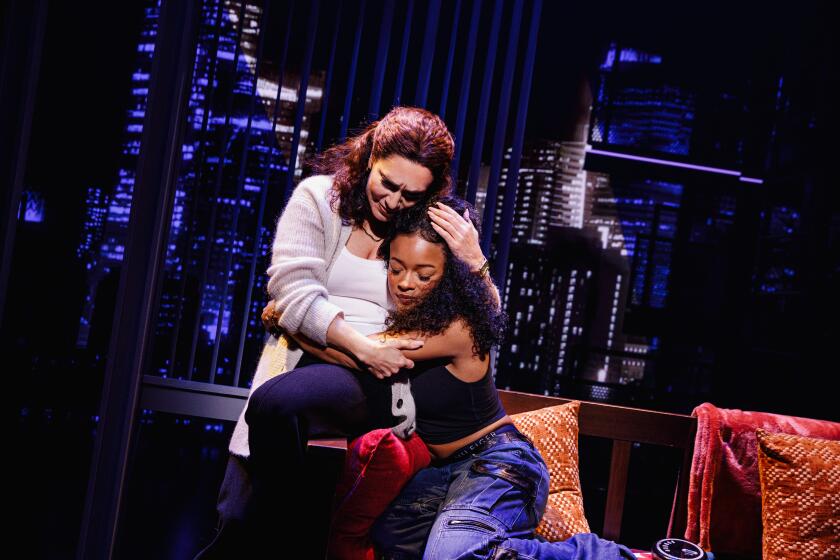Where to Put a Cathedral, Recreate L.A.
Now is the time to reconcile and unify Los Angeles by means of the very same challenge--the siting of the forthcoming Cathedral of Our Lady of the Angels--that has created so much controversy in the city. This month, a cathedral site-selection committee will make its recommendation to Cardinal Roger Mahony as to where it thinks the new cathedral should be built.
The architectural and planning firm of Johnson Fain and Pereira Associates, meanwhile, has completed for the Civic Center Authority, with the support of the Central City Assn., a Civic Center Shared Facilities and Enhancement Plan. At long last, thanks to this plan, an impressive instance of large-scale urban planning and design, the core of Los Angeles--from the Indian village of Yang-na, to City Hall, the historic Times Mirror building and the Cathedral-to-be--would be integrated, energized and launched into the future.
Will the Cathedral of Our Lady of the Angels designed by Jose Rafael Moneo, one of the world’s leading architects and winner of the Pritzker Architecture Prize this year, come into synergy with this planned City Square, or will the creations of these architects, because of controversy, bitterness and intransigence, be separated from each other, with Los Angeles the loser?
Johnson Fain and Pereira Associates began its researches with a consideration of the topographical basis of Los Angeles, how Native Americans used the region, how the Spanish and Mexicans laid it out, how Lt. Edward Ord surveyed and mapped the city in 1849, and how American Los Angeles grew in the 19th and 20th centuries. The plan rediscovers and builds upon an identity that has been unfolding for more than 200 years, re-presenting, if you will, the essential DNA code of the historic core as an integrated whole. It is as if a grand city has been in gestation for 200 years and is now being born through the subtle midwifery of a design scheme linking what is already there, what is coming into existence (like the cathedral) and what should be.
At the heart of the urban plan is a landscaped, four-block City Square fronted by City Hall (plans to retrofit the building are still on hold), the Times Mirror building, the New Otani Hotel and St. Vibiana’s. Here is ground zero, among other things, of the second- or third-largest administrative/governmental complexes in the United States. Even more dramatic, here is to be the town square, the zocalo, busy with pedestrian traffic, ringed by buildings representing church and state (a cathedral and City Hall), as well as a newspaper building and a hotel. In 1572, the Law of the Indies governing the design and construction of Spanish cities in the New World, such as Los Angeles came to be in 1781, called for such a space.
Site 1 under consideration by the archdiocese--the southwest corner of Second and Main streets--would have the new cathedral face the proposed City Square in direct line of sight (once the Cal Trans building is removed, as currently called for in the Civic Center Masterplan) with the south facade of City Hall, which has always been its most public and ceremonial wing. Site 2--the Cal Trans parking lot bounded by First, Second, Main and Los Angeles streets--also faces the City Square but would cut its four-square-block dimensions by half. Site 3--the northwest corner of First and Spring streets, directly across the street from the Times Mirror building--also faces the City Square, diagonally across from City Hall. Site 4, atop Bunker Hill, is the full block bounded by First, Second, Grand and Olive streets, directly opposite the stalled Disney Center and diagonally across from the Dorothy Chandler Pavilion. Site 5, also atop Bunker Hill, is the double block bounded by Grand, Hill and Temple streets and the Santa Ana Freeway. Site 6 is at Sixth and Bixel streets, on the western side of the Harbor Freeway.
Should the new cathedral be built on either the southwest corner of Second and Main streets or on the block bounded by First, Second, Main and Los Angeles streets, it would, for a thousand years, energize the forthcoming City Square in the manner of the great cathedrals of Europe. It would state its message of religious value directly to the secular world. It would open out on to the square, be accessible to all arriving by foot. It would be woven into the very fabric of the city, which also bears the name of Our Lady Queen of the Angels. Even if the new cathedral were sited on the northwest corner of First and Spring streets, facing the Times Mirror building, it would still possess this quality of pedestrian access, of classic urbanism, although not to the same degree. (Unfortunately, the third site, if chosen, would put the new cathedral into direct competition with City Hall and the bland, modernist Criminal Courts Building.)
If, however, the cathedral is sited on Bunker Hill or across the Harbor Freeway, it might find itself, despite its architectural grandeur, increasingly isolated and detached from the life of the city and ordinary people. Redeveloped in elite housing and a performing-arts complex, Bunker Hill does not creates an environment supportive of a cathedral seeking to serve all. Should Moneo’s cathedral face Frank O. Gehry’s Disney Center, the dialogue would be about architecture, not worship. Tourists might come in buses to admire masterpieces of architecture, but would ordinary people come to pray? East Los Angeles and the vast majority of downtown workers would be sealed off from the cathedral.
Site five--the double block bounded by Grand, Hill and Temple streets and the Santa Ana freeway--is the most intractable, outpacing the Sixth-and-Bixel site in this regard, which at least has the populous Pico Union district and Koreatown on its western flank. On one side of this site, on the heel of Bunker Hill, is the county power plant; on the other, an impassable freeway trench. There is no street life on these blocks, barricaded as they are by a power plant, an abandoned Hall of Records and a freeway. Even more than the Disney site perhaps, this second Bunker Hill site would demand that people approach the cathedral only by bus or automobile. Architecturally, a cathedral on this site would remain a free-standing, self-referencing monument, devoid of urban context. A drive-in cathedral on such a site might as well be in Garden Grove.
The Sixth and Bixel site suffers from the same deficiency. The Harbor Freeway would virtually wall off access, pedestrian or automotive, from the downtown. Nearby, a vacant Unocal building and a near-vacant Arco building would soon have the company of an empty cathedral. Thousands might glimpse the cathedral each day, like the freeway-adjacent Mormon temples in San Diego, Los Angeles and Oakland; but few would leave the freeway, double back and cross it, then trace the tortuous hillside route to the cathedral.
Property atop Bunker Hill, moreover, will cost the archdiocese $90 a square foot, while property adjacent to the proposed City Square can be had for $40 a square foot. When the cardinal proposed the Cathedral of Our Lady of the Angels for the St. Vibiana’s site, his financial calculations were based upon his ownership of the property. Should he move to Bunker Hill, he would have to pay relatively higher prices, which could push the cost of the cathedral project beyond acceptable levels. On the other hand, the two Bunker Hill sites, and the Sixth and Bixel site, remove the cathedral as far as possible from the abandoned shell of St. Vibiana’s, which the cardinal had hoped to transform into a new cathedral ushering in the third millennium of Christianity.
He can still do so, of course, if he chooses to ignore the Los Angeles Conservancy and build on Site 1 or Site 2, adjacent to St. Vibiana’s and facing City Square. At some point, the archdiocese will regain sovereignty over St. Vibiana’s and will then, depending upon circumstances, make its own decisions. If the cardinal, overcoming his understandable repugnance to return to a site adjacent to St. Vibiana’s, which has caused him such pain, chooses site one or two, he would place the new cathedral at its point of highest energy, facing City Square, accessible to all classes and conditions. At the same time, he would retain sovereignty over the adjacent St. Vibiana’s. When Conservancy opposition has run its legal course, the archdiocese can still demolish St. Vibiana’s, sell the land or, retaining it, construct there a cathedral-related complex. Which is exactly what the cardinal wanted to do in the first place.
Should the Cathedral of our Lady of the Angels face City Square, linked by landscaped promenades to the Plaza and Olvera Street, City Hall and Union Station, Bunker Hill and the downtown, the Cathedral will triumphantly function as Cardinal Mahony has always wished it to function--as a catalyst, a transforming agent, a bridge linking the urbanism of the City of Man with the more subtle but equally necessary urbanism of that other city, that New Jerusalem, that City of God ever haunting the religious imagination of the Judeo-Christian tradition. Here, where Los Angeles began, it will begin anew: redeemed, transformed, rich with future promise. The site-selection committee might advise, but it is the responsibility of Cardinal Mahony to make the decision between City Square or Bunker Hill. It is a decision for time--for the millennium to come--and for eternity.
(BEGIN TEXT OF INFOBOX / INFOGRAPHIC)
Proposed City Square
How one site for the new cathedral could integrat downtown.
* Source: Johnsom, Fain & Pereira Associates.
More to Read
The biggest entertainment stories
Get our big stories about Hollywood, film, television, music, arts, culture and more right in your inbox as soon as they publish.
You may occasionally receive promotional content from the Los Angeles Times.






